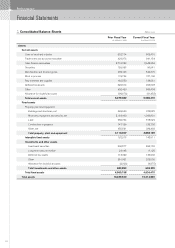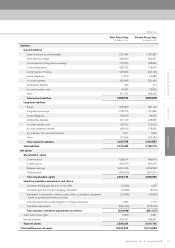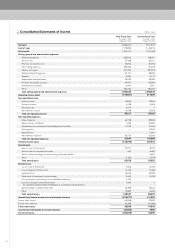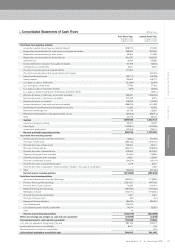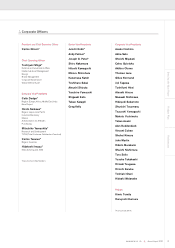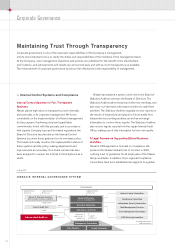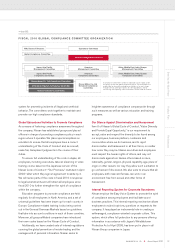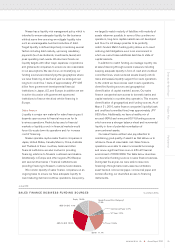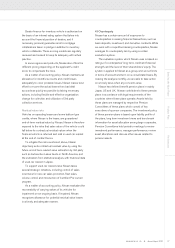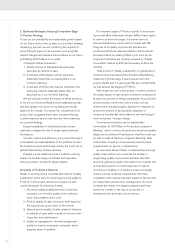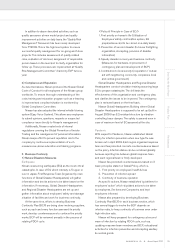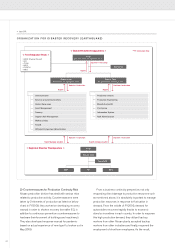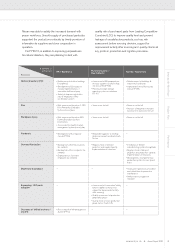Nissan 2010 Annual Report Download - page 38
Download and view the complete annual report
Please find page 38 of the 2010 Nissan annual report below. You can navigate through the pages in the report by either clicking on the pages listed below, or by using the keyword search tool below to find specific information within the annual report.
36
2) Financial Market
Nissan is exposed to various financial market related
risks, such as foreign exchange, interest rate and
commodity. It is general policy of Nissan not to use
derivative products as a primary tool to manage these
risks, as it will not provide a permanent solution to
mitigate the risks. Nissan is taking following measures to
minimize financial market risks.
Foreign exchange
As a company engaged in export activities, Nissan is
faced with various foreign currency exposures which
results from currency of input cost being different than
currency of sale to customer. In order to minimize foreign
exchange risk on a more permanent basis, Nissan is
working to reduce foreign currency exposure by such
measures as shifting production to overseas, and
procurement of raw material and parts in foreign
currencies. In the short term, Nissan may hedge risks in
foreign exchange volatility within a certain range by using
derivative products in accordance with the Company’s
“Policies and Procedures for Risk Management and
Authority Regarding Derivative Transactions”.
Interest rate
The interest rate risk management policy is based on two
principles: long-term investments are financed at fixed
interest rates while liquidity reserves are built at floating
rates.
Commodity
Nissan’s direct purchase of raw commodities is limited as
most of our commodities’ exposure results from parts
purchases from suppliers where commodity price is
incorporated in the price of parts that Nissan pays to the
suppliers. In many cases, Nissan compensates all or
some of the commodity price volatility to parts’ suppliers
and thus Nissan is exposed to commodity price volatility.
For precious metals, Nissan is making continuous efforts
to reduce its usage (such as what is used for catalysts)
by technological innovation, in order to minimize
commodity risk. In the short term, Nissan manages
commodities price volatility exposure through use of
fixed rate purchase contract where commodity price is
fixed for a period of time and also Nissan may hedge
risks in commodity price volatility within a certain range
by use of derivative products in accordance with the
Company’s “Policies and Procedures for Risk
Management and Authority Regarding Derivative
Transactions”.
3) Sales Finance
Interest rate risk management
The Sales financing business is exposed to interest rate
risks. Interest rate risk is defined as the potential
variance in the earnings of an entity or the fair value of
the portfolio that would result from a fluctuation in the
general level of market interest rates where funds with
differing fixed-rate periods or differing terms are
financed and invested.
Nissan measures the risks by using the sensitivity
analysis with various interest rate scenarios and
determines the risk tolerance level. Nissan controls the
interest rate maturities of both assets and liabilities to
maintain the risks within the acceptable tolerance level.
Sensitivity analysis mentioned above uses statistic
models, such as a Monte Carlo Simulation Method.
However, actual fluctuation of market interest rate and its
impact may deviate significantly from the assumptions
used in the model.
Nissan also enters into interest rate derivative
financial instruments to maintain the potential variability
of interest rates at desired level of risk exposure. The
main objective of these transactions is to mitigate the
risks and not to pursue the speculative profit
maximization.
Credit risks
Nissan is exposed to the risks of failure to recover the
full value of financial receivables for Auto credit and
Lease business with retail customers and for Dealer
finance business, due to change of economic situation
and credit quality of customers. Nissan manages the
credit risks closely by establishing effective screening
and collection system and structure.
Credit applicants are all subject to credit assessments
of their creditworthiness under a detailed scoring system.
Based on the information directly obtained from
applicants and from credit bureau, loan authorization is
made in a comprehensive manner by considering the
following points: applicant’s credit history; applicant’s
capacity to pay which is estimated by debt ratio, payment
to income ratio, disposable income; applicant’s stability;
and loan condition including the loan collateral, loan
advance and payment terms. In addition to carrying out
this screening process, Nissan takes into account
qualitative information by conducting field visit to
customers or referring the past business records with
Nissan, in accordance with characteristics of regional
business practices and risks.


